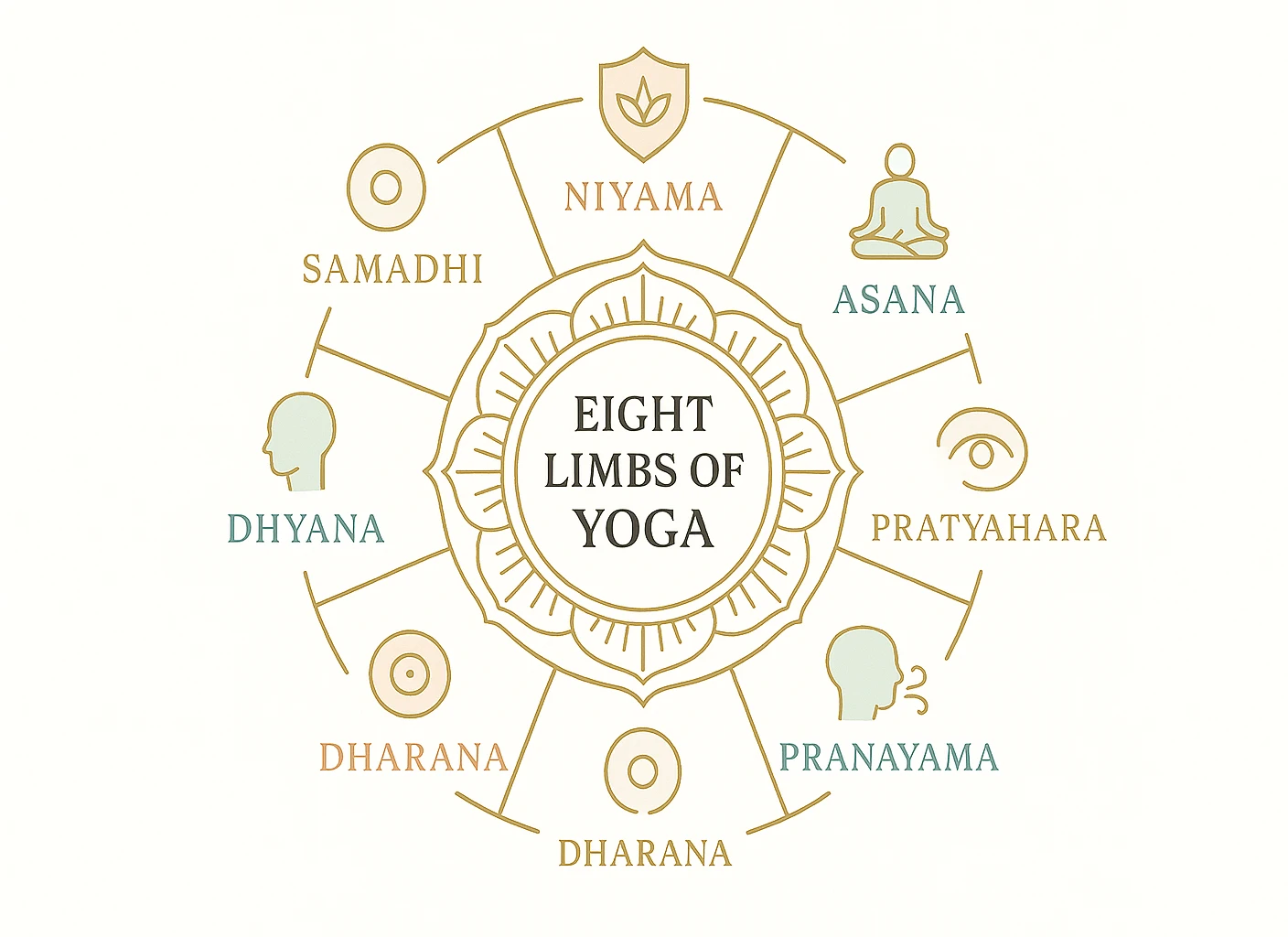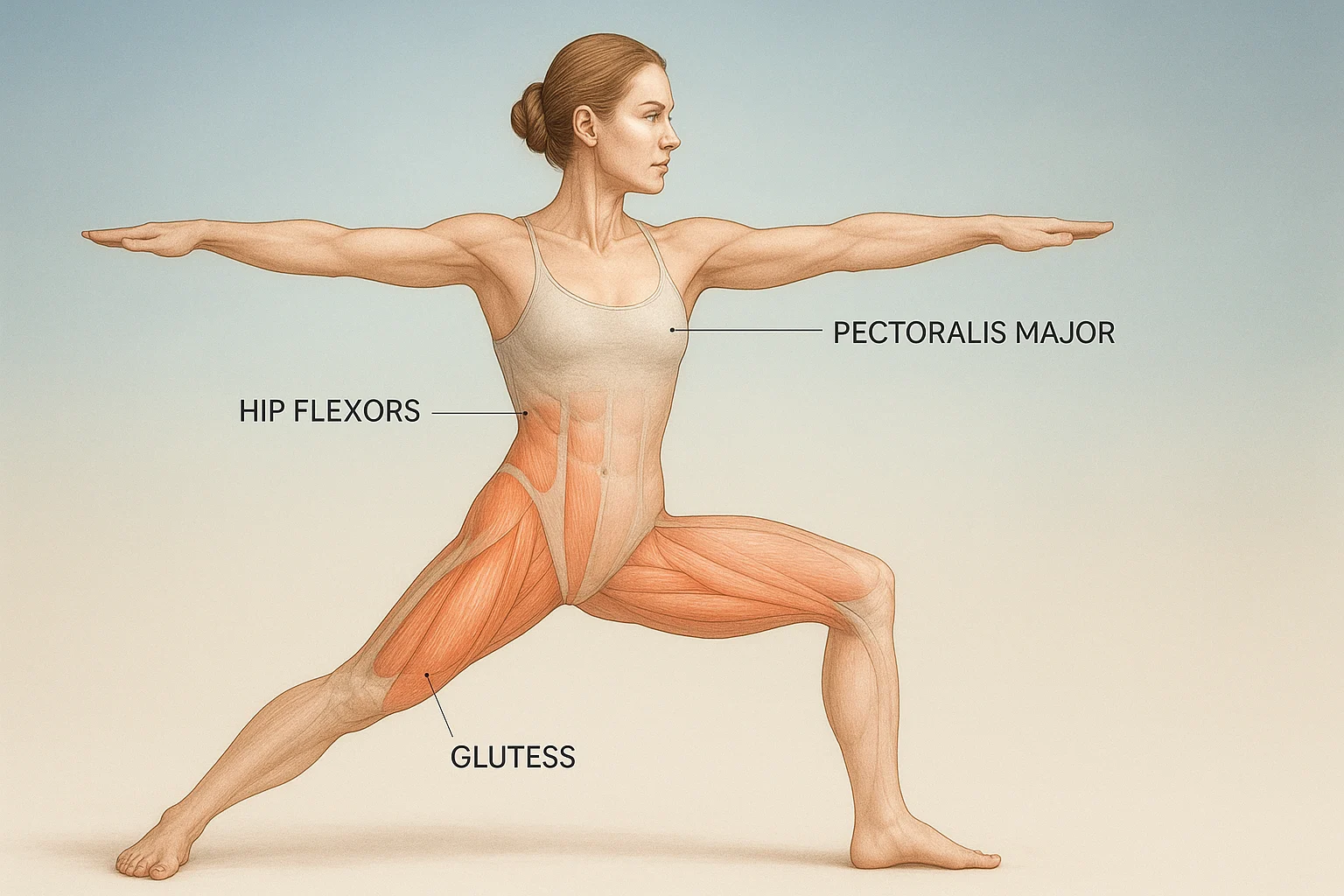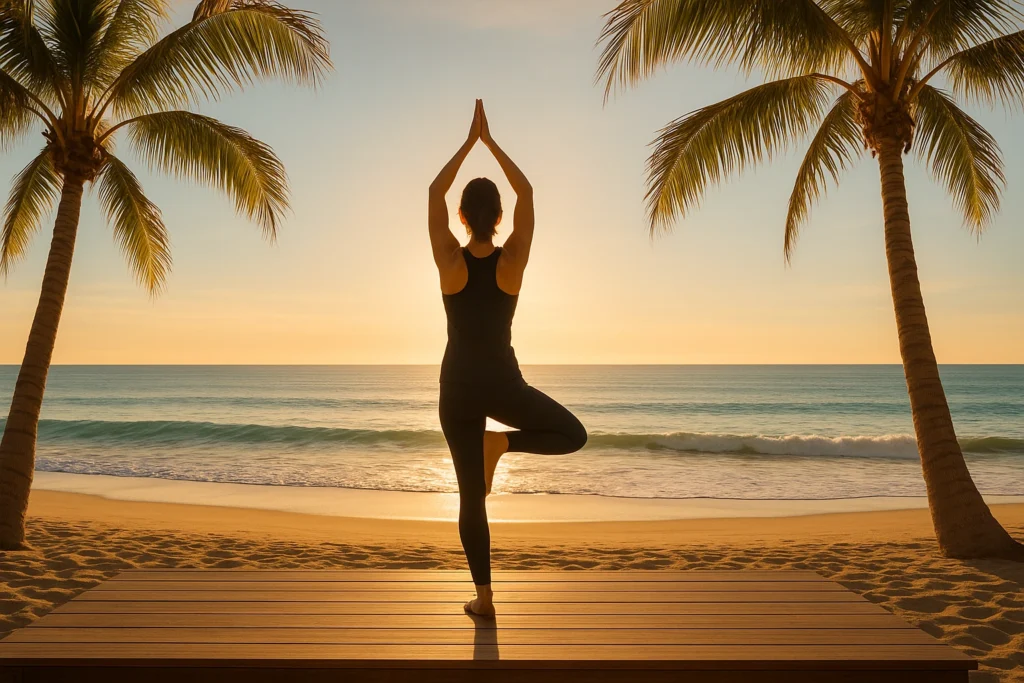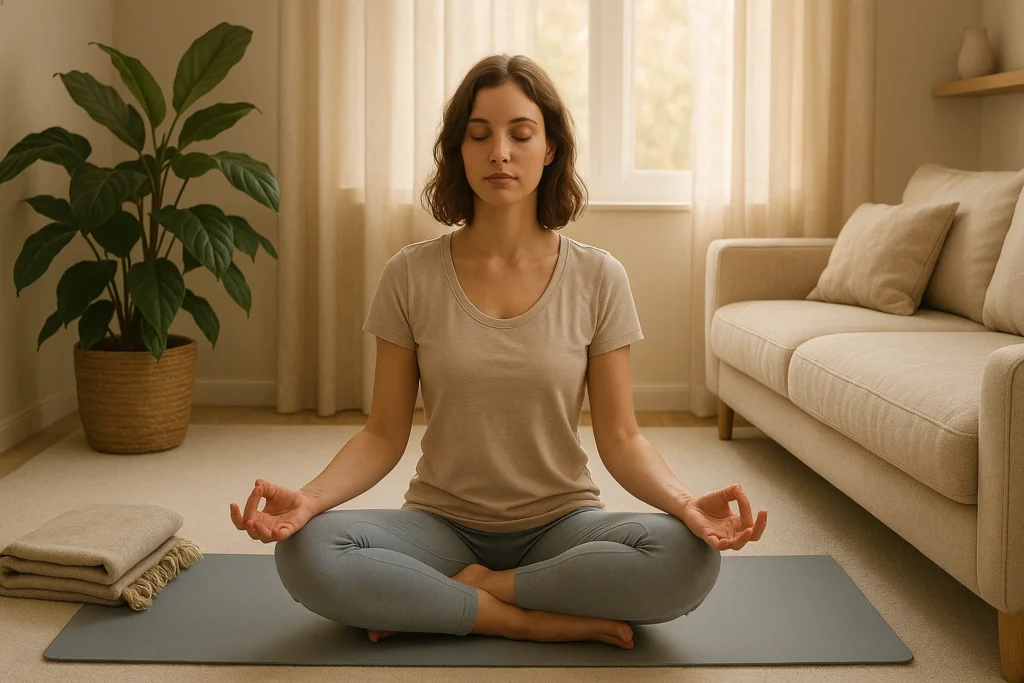
This yoga philosophy guide is a down-to-earth start for seeing what’s behind yoga—beyond the shapes. When I first stepped onto a mat, I figured it was just stretching; over time I realized it blends lived wisdom with practical body know-how. Ready to explore the Eight Limbs, the history that shaped yoga, and how your body actually moves? Whether you’re brand-new or a longtime yogi, let’s look for a balanced path—what’s getting in the way right now?
Table of Contents
Key Takeaways from This Yoga Philosophy Guide
Here’s what you’ll walk away with after diving into this guide:
- Holistic System: Yoga’s more than poses—it blends philosophy, ethics, and practices to spark inner peace.
- Eight Limbs Roadmap: Patanjali’s Yoga Sutras offer a clear path for ethical living and spiritual growth.
- Anatomy for Safety: Knowing your body may support safer, more effective postures and help reduce the risk of common strains.
- Philosophy Meets Anatomy: Ethics like Ahimsa guide mindful movement, honoring your body’s limits.
- Timeless Wisdom: From India to Morocco, yoga’s teachings offer tools for modern well-being.
Unveiling the Heart of Yoga
Your Yoga Philosophy Guide
When I first tried yoga, I was all about asanas—those flowing sequences or tricky balances. But I quickly learned poses are just the beginning. Want to know what yoga’s really about? It’s a journey to connect your mind, body, and spirit, and its philosophy makes every practice feel alive.
What Is Yoga, Really?
The word “yoga” comes from the Sanskrit yuj—to yoke or unite. It’s about bringing mind, body, and spirit into the same conversation, grounded in a philosophical tradition that values ethical living and steady inner calm. Think of it as a long-standing Indian practice for getting to know yourself. As Jigar Gor puts it, “Yoga isn’t about touching your toes—it’s about what you learn on the way down.” For me, staying with the burn in Warrior II taught the patience I use every day.
Why Dive into Yoga Philosophy?
Maybe you’re thinking, “I just want to stretch—why add philosophy?” Fair. I felt that way too, until the backstory turned routine classes into something that mattered. Here’s how it can lift your practice:
- Intentional Movement: Ahimsa (non-harming) keeps you safe by respecting your body’s limits.
- Mindfulness: It can help you notice what’s actually happening—on the mat and when life gets loud.
- Stress Relief: Santosha (contentment) may help you find calm in hectic moments.
- Ethical Living: Yamas and Niyamas inspire kinder choices.
- Holistic Health: Philosophy and anatomy work together to nurture you fully.
Philosophy’s like a compass for a practice that matters. Want a glimpse of yoga’s past? See the history timeline below.
Yoga Principles Guide: Roots and Wisdom
Ever wonder what sits at yoga’s core? This page is both a yoga principles guide and a yoga history overview: a quick tour through 5,000 years that introduces yoga philosophical roots—teachings many practitioners still lean on today.
Yoga’s Ancient Origins
Quick tour of how yoga has evolved in India. For the full arc, see the detailed yoga history timeline. Snapshot:
- Indus-Saraswati (3000–1900 BCE): Ancient seals depict seated figures that some interpret as early meditative or yogic postures (interpretations vary).
- Vedic Period (1500–500 BCE): The Vedas mention ascetic practices.
- Pre-Classical (500 BCE–200 CE): Upanishads and Bhagavad Gita bring in Karma and Bhakti Yoga.
- Classical (200–800 CE): Patanjali’s Yoga Sutras lay out Raja Yoga.
- Post-Classical (800–1700 CE): Hatha Yoga focuses on physical cleansing.
- Modern (1700 CE–Present): Teachers like B.K.S. Iyengar take yoga global.
Yoga’s story shows how it adapts worldwide, from Marrakech studios blending Sufi mysticism to Vinyasa classes everywhere, connecting us through mindfulness.
Patanjali’s Yoga Sutras
The Yoga Sutras, often dated to ~200–400 CE, are central to this yoga philosophy guide. Traditionally they’re compiled into ~195–196 sutras (counts vary by lineage), outlining Raja Yoga for mental clarity. For an accessible overview, see Yoga Journal.
This post has affiliate links. We may earn a commission. Learn more.

The Eight Limbs: Your Path to Growth
Patanjali’s Eight Limbs are like a roadmap for a balanced life. When I first learned them, they transformed how I approach yoga and daily choices. Here’s how they work:
1. Yamas (Ethical Guidelines)
These “don’ts” guide how you treat others. For example, practicing Ahimsa in a heated work meeting means choosing kind words over snapping back. Learn more about the Yamas and Niyamas.
- Ahimsa: Choose compassion—think kind words to a struggling colleague.
- Satya: Speak truth, but keep it gentle.
- Asteya: Respect others’ time and resources.
- Brahmacharya: Save energy with moderation.
- Aparigraha: Let go of clinging to things or outcomes.
2. Niyamas (Personal Observances)
These “dos” are the personal side. On a soggy morning, practicing Santosha helped me notice the smell of rain instead of grumbling. Try these:
- Saucha: Keep your body and mind clear.
- Santosha: Find joy in small moments, like a sunrise.
- Tapas: Build grit with daily practice.
- Svadhyaya: Reflect through journaling or reading The Heart of Yoga.
- Ishvara Pranidhana: Let go and trust life’s flow.
3. Asana (Physical Postures)
Builds strength to prep for meditation.
4. Pranayama (Breath Control)
Breathing techniques like Ujjayi may help calm your mind.
5. Pratyahara (Sense Withdrawal)
Turn inward, tuning out distractions.
6. Dharana (Concentration)
Focus on one thing, like a candle flame.
7. Dhyana (Meditation)
Find effortless awareness in deep meditation.
8. Samadhi (Absorption)
Feel oneness, like sinking into a peaceful ocean.
Modern Applications and Advanced Practices
Yoga philosophy fits today’s styles like Vinyasa, where I sync breath with movement, or Yin, where I hold poses and reflect on Santosha. Advanced practices like Tantra explore energy flow, while Kundalini aims to awaken inner energy with breath and mantra. These bridge ancient wisdom to modern life.
Meditation Practices
Meditation makes yoga philosophy real. When I’m stressed, repeating “Om” in mantra meditation may help ground me quickly—consider trying it next time you’re frazzled. Mindfulness meditation, just watching thoughts without judgment, helps me stay steady whether I’m on the mat or stuck in traffic.
At-Home Sleep & Stress Test
Get a simple baseline to guide your wind-down routine and meditation practice — measure, then manage.
Check availability Partnered
Use code Max15 for 15% off sitewide.
Not medical advice; consult a healthcare professional for personal guidance.
Other Philosophical Concepts
More ideas from yoga philosophical roots add depth to your practice. Here’s what I’ve found useful:
- Karma: Your actions shape what’s next.
- Dharma: Live your purpose.
- Samskara: Clear out old mental patterns.
- Gunas: Balance qualities like Sattva (clarity).
- Chakras: In some traditions, energy centers said to influence well-being.
- Nadis: Channels said to carry prana (energy).
Philosophy’s your guide for a practice that matters. Want a quick look at yoga’s past? Check the timeline above.
Yoga Anatomy: Your Key to Safe Practice
Philosophy gives you the why; anatomy is the how. Early on, learning a few basics saved me from wrist twinges and made poses feel better. Ready to practice with more ease?
Yoga Anatomy Basics: Why It Matters
In plain terms, the fundamentals of yoga anatomy help you sidestep common tweaks and make each pose work for your body. If you’re new to yoga anatomy basics, start with joint actions, breath, and a few simple alignment cues. Let me break it down:
- Injury Prevention: Know your joints to help dodge strains.
- Effectiveness: Align well for better results.
- Body Awareness: Tune into what your body’s saying.
- Empowerment: Tweak poses to fit your needs.
- Sustainability: Keep practicing safely for years.

Key Muscle Groups in Yoga
Focus on these muscles to nail your poses. For deeper yoga anatomy insights, check out Leslie Kaminoff’s work:
| Pose | Muscle Group | Role |
|---|---|---|
| Downward Dog | Hamstrings, Shoulders | Lengthen hamstrings, stabilize shoulders. |
| Warrior II | Hip Flexors, Glutes | Engage hips, strengthen glutes. |
| Plank | Core, Shoulders | Stabilize spine, support wrists. |
| Bridge | Glutes, Spinal Erectors | Lift pelvis, extend spine. |
Yoga Alignment Principles
Good alignment can support safer movement and, in many traditions, is said to facilitate prana (energy) flow. Want specifics? Check out yoga alignment principles for more tips:
- Stable Foundation: Root through your feet in Mountain Pose.
- Spinal Elongation: Lengthen your spine for ease.
- Joint Stacking: Align knees over ankles in Warrior II.
- Core Engagement: Draw your navel in for stability.
- Soft Joints: Don’t lock knees in Downward Dog.
- Breath Connection: Inhale to lift, exhale to deepen.
- Listen to Your Body: Respect your limits with Ahimsa.
Preventing Common Injuries
Stay mindful to help protect these areas:
- Lower Back: Engage core, bend knees in forward folds.
- Knees: Track knees over ankles in lunges.
- Shoulders/Wrists: Stack joints in Chaturanga.
- Hamstrings: Warm up before deep stretches.
Weaving Philosophy and Anatomy Together
Philosophy and anatomy go hand in hand. Take Ahimsa—it’s not just about kindness but also about moving gently to avoid injury. Meanwhile, anatomy helps you sit comfortably in meditation.
The Mind-Body Connection
Your thoughts may affect your body, and your body can shape your mind. I’ve noticed tight shoulders can make me feel stressed, while a backbend can lift my mood. Pranayama ties it together and may help calm you with each breath.
Philosophy Informs Anatomy
Yoga’s ethics guide your movements. Here’s what I mean:
- Ahimsa: Don’t force poses—move gently.
- Santosha: Accept where your body’s at today.
- Tapas: Stay committed to refining alignment.
- Svadhyaya: Listen to your body’s signals.
Anatomy Supports Philosophy
Building strength can make meditation more comfortable, and many traditions hold that steady alignment supports prana flow, grounding your mind.
Your Yoga Path Finder
Feeling lost on where to begin? This quick quiz will point you to the yoga focus that fits you best.
Find Your Ideal Yoga Practice 🧭
Answer three questions to find your perfect yoga focus.
1. What drew you to yoga?
Bringing Yoga Wisdom into Daily Life
Yoga doesn’t end at savasana—it can shape your day. Here’s how I work the principles into real life, from that first cup of coffee to how I wind down at night.
Living the Yamas and Niyamas
These ethics are a steady compass for everyday choices. When I’m tempted to snap, Ahimsa nudges me to pause and pick kinder words. Here’s how you can bring them to life:
- Ahimsa: Use kind words, like cheering up a friend who’s down.
- Satya: Be honest, but keep it gentle.
- Asteya: Give full attention in conversations.
- Brahmacharya: Cut back on screen time to save energy.
- Aparigraha: Let go of expectations.
- Saucha: Clear your mind and space.
- Santosha: Find joy in small moments, like a sunrise.
- Tapas: Stick to daily meditation.
- Svadhyaya: Journal to reflect on your day.
- Ishvara Pranidhana: Let go of worries.
Mindfulness in Everyday Moments
Ever turned everyday tasks into tiny meditations? Paying attention to small moments brings surprising calm. Try these:
- Eating: Set the utensil down between bites and actually taste the spices.
- Walking: Notice heel–toe contact and the swing of your arms.
- Communication: Leave a breath before replying so the other person finishes.
- Chores: Feel the warm water and the slick plate—let that be the practice.
Tips for Beginners
New to yoga? Don’t worry—I was there too. These tips, plus yoga philosophy books for beginners, will set you up for success:
- Find a teacher who focuses on alignment.
- Go slow, respecting your body’s limits.
- Grab Light on Yoga by B.K.S. Iyengar for a great start.
- Use props to make poses feel right.
- Focus on your breath to stay calm.
- Dip into meditation and yoga’s philosophy.
- Listen to your body to avoid pain.
- Stick with short, daily practices.
- Keep learning with books or online courses.
Ready to start? Try a short meditation today and see how it feels!
Ayurvedic-Friendly Meal Planning
Turn insights into a gentle, doable “what to eat” plan that complements your yoga & mindfulness routine.
Explore the plan Partnered
Use code BOUNTY10 for extra 10% off.
Not medical advice; consult a healthcare professional for personal guidance.
Frequently Asked Questions
Conclusion: Your Yoga Journey’s Just Beginning
This yoga philosophy guide—paired with the fundamentals of yoga anatomy—lights the way to a more balanced, purposeful you. From Patanjali’s Eight Limbs to nailing mindful alignment, you’ve got tools to grow and discover yourself. Whether you’re diving into the Yoga Sutras or tweaking your Downward Dog, keep exploring with an open heart. What’s next for your yoga journey? Namaste. 🙏


